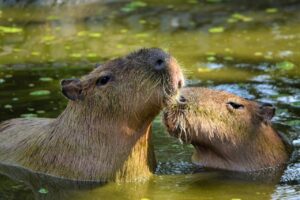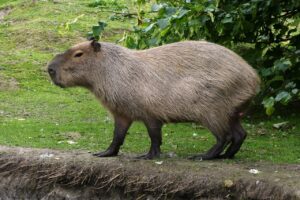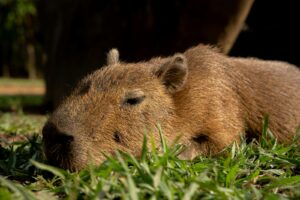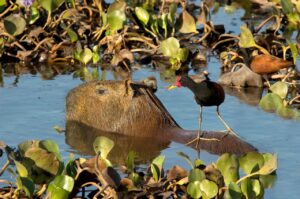Capybaras are fascinating creatures that capture the imagination of people worldwide. These gentle giants are known for their unique characteristics and behaviors, making them a subject of interest for both adults and children alike. From their impressive size to their social nature, capybaras have many interesting facts that often surprise even the most knowledgeable animal enthusiasts.
This article delves into 10 surprising and interesting facts about capybaras. We’ll explore their status as the world’s largest rodent, their remarkable aquatic adaptations, and their social behaviors. Additionally, we’ll look at their unique dietary habits and how they interact with their environment. By the end, readers will have a deeper appreciation for these remarkable animals and their place in the natural world.
The World’s Largest Rodent
Capybaras hold the distinction of being the largest living rodents on Earth. These remarkable creatures have captured the attention of animal enthusiasts worldwide due to their impressive size and unique characteristics.
Size comparison
When compared to other rodents, capybaras stand out as giants in their family. They are significantly larger than beavers, which are the second-largest rodents in the world. An adult capybara can reach a length of up to 4.4 feet (134 cm) and stand about 2 feet (60 cm) tall at the shoulder 1. This size makes them comparable to medium-sized dogs or small pigs, rather than typical rodents like mice or rats.
Weight range
The weight of capybaras is equally impressive. Adult capybaras typically weigh between 77 to 146 pounds (35 to 66 kg) 1. However, some individuals can grow even larger. The heaviest recorded wild female capybara weighed an astonishing 201 pounds (91 kg), while the heaviest wild male reached 162 pounds (73.5 kg) 1. Interestingly, female capybaras tend to be slightly heavier than males, which is uncommon among mammals.
Physical characteristics
Capybaras have a distinctive appearance that sets them apart from other rodents. They have a barrel-shaped body with a heavy, blunt muzzle 2. Their fur is coarse and sparse, ranging in color from reddish-brown to grayish on the upper parts of their body, with a yellowish-brown underside 2. This thin coat serves a purpose, as it helps them dry quickly when they exit the water.
One of the most interesting facts about capybaras is their adaptation to a semi-aquatic lifestyle. Their eyes, ears, and nostrils are positioned high on their heads, allowing them to remain alert while mostly submerged in water 3. This feature helps them stay safe from predators while enjoying their aquatic habitat.
Capybaras have partially webbed toes, with four on their front feet and three on their back feet 1. This adaptation aids in swimming and navigating through their wetland environments. Their strong, hoof-like nails provide traction on both land and in water 2.
Another unique characteristic of capybaras is their teeth. Like other rodents, their teeth grow continuously throughout their lives 2. This ongoing growth compensates for the wear and tear caused by their diet of tough grasses and aquatic plants. An adult capybara can consume up to 8 pounds (3.6 kg) of grass per day 4.
These fascinating creatures have made their mark as the largest rodents in the world, with physical adaptations that perfectly suit their semi-aquatic lifestyle. Their size, weight, and unique features make them stand out in the diverse world of rodents, capturing the imagination of both children and adults alike.
Aquatic Adaptations
Capybaras are well-suited for life in and around water, with remarkable adaptations that enable them to thrive in aquatic environments. These interesting facts about capybaras highlight their unique abilities and preferences for watery habitats.
Webbed feet
One of the most notable aquatic adaptations of capybaras is their partially webbed feet. This feature helps them to swim efficiently and maneuver through water with ease. The webbing between their toes acts like flippers, allowing them to propel themselves through rivers, lakes, and swamps. On land, these webbed feet serve another purpose by preventing capybaras from sinking into muddy terrain when walking on wet ground.
Underwater abilities
Capybaras have impressive underwater capabilities that contribute to their survival in aquatic environments. They can stay submerged for up to five minutes, which is a useful adaptation when trying to escape from predators 5. This ability to remain underwater for extended periods is made possible by several physical characteristics. Their eyes, ears, and nostrils are positioned high on their heads, allowing them to stay mostly submerged while still being able to breathe, see, hear, and smell 6. Additionally, capybaras can press their outer ears extremely close to their heads, effectively closing them to prevent water from entering while submerged.
Another interesting fact about capybaras is that their bodies are only slightly denser than water, which allows them to stay afloat more easily 6. This buoyancy, combined with their strong swimming abilities, makes them well-adapted to their semi-aquatic lifestyle. Capybaras use their long hind legs and partially webbed feet to effortlessly propel themselves through the water, making them strong swimmers.
Habitat preferences
Capybaras have a strong affinity for aquatic environments and are found in various water-rich habitats across Central and South America. They show a preference for areas with easy access to water, such as flooded grasslands, marshes, swamps, and areas bordering rivers, ponds, streams, and lakes 6. These habitats provide capybaras with the necessary resources for their survival and well-being.
Water plays a crucial role in the life of capybaras. It serves as a source of food, as they consume water plants and grasses found in and around aquatic environments. Additionally, water bodies provide capybaras with a means of escape from danger and help them regulate their body temperature. Capybaras often wallow in shallow water and mud to keep cool during hot days before venturing out in the evening to graze 4.
The reliance on water extends beyond mere survival for capybaras. Their skin is prone to drying out, making regular access to water essential for maintaining their skin health. Without frequent contact with water, a capybara’s skin can become dry and uncomfortable 7. This dependence on aquatic environments has shaped their habitat preferences and behavior, making them true semi-aquatic mammals.
Social Behaviors
Capybaras are highly social animals that live in groups, typically consisting of 10-20 individuals. These groups, also known as herds, have a complex social structure that contributes to their survival and well-being. The social behaviors of capybaras are fascinating and provide interesting facts about their interactions with each other and other species.
Group dynamics
Capybara groups have a hierarchical structure with a dominant male and several females. The dominant male, usually the largest in the group, leads the pack and has priority access to resources and mating opportunities. Second in command is the alpha female, who is also typically the largest female in the group. This social structure helps maintain order and protect the family unit.
The size of capybara groups can vary depending on environmental factors. During the dry season, when water sources become scarce, groups of up to 100 individuals may gather at remaining water holes. In contrast, during the wet season, group sizes tend to be smaller, with up to 40 individuals 1. This flexibility in group size allows capybaras to adapt to changing environmental conditions and resource availability.
Communication methods
Capybaras have developed various methods of communication to maintain social bonds and convey important information within their groups. These rodents are notably vocal, using a range of sounds to express different messages and emotions. Their vocalizations include chirps, whistles, purrs, huffs, and even barks. Each sound serves a specific purpose in their communication repertoire.
For example, infants and young capybaras constantly emit a guttural purr, which may help them stay in touch with the group. When in a state of contentment, capybaras produce low clicking sounds. In times of danger, they use sharp, prolonged whistles or alarm barks to alert the group of potential threats. Interestingly, most warning calls come from subordinate males, prompting other group members to stand alert or plunge into the nearest water for safety.
In addition to vocalizations, capybaras use visual signals and scent marking to communicate. Male capybaras have enlarged scent glands on top of their snouts, known as morrillos, which signal their status and may attract females. The size of a male’s morrillo is often an indication of his rank within the group hierarchy.
Interactions with other species
Capybaras are known for their unique ability to interact amicably with a variety of other animals. Their gentle temperament and non-threatening demeanor make them approachable to other species, leading to interesting interspecies relationships. These interactions often occur in shared habitats, such as wetlands and rivers, where capybaras coexist with diverse wildlife.
One fascinating aspect of capybara behavior is their mutualistic relationships with birds. At least nine species of birds have been observed increasing their feeding rates by associating with capybaras. These include jacanas, scarlet ibises, and various species of egrets. The birds use capybaras as perches, walking alongside them to catch flushed prey or foraging on their skin for parasites. This relationship benefits both parties, as the birds receive food while the capybaras get relief from parasites.
Capybaras also coexist peacefully with domestic cattle in some areas, sharing grazing grounds without conflict. However, they face threats from predators such as jaguars, pumas, and wild dogs. When attacked, capybara groups form defensive huddles with young in the center and adults facing outwards, demonstrating their strong social bonds and protective instincts.
Unique Dietary Habits
Capybaras have fascinating dietary habits that set them apart from other rodents. These interesting facts about capybaras highlight their unique adaptations and behaviors related to food consumption.
Herbivorous diet
Capybaras are strict herbivores, with their diet consisting almost exclusively of plant matter. In the wild, they primarily consume a variety of grasses and aquatic plants. Their diet is remarkably diverse, reflecting the rich biodiversity of their natural habitats, which include savannas, dense forests near bodies of water, and wetlands across South America.
These rodents have a particular preference for grasses, which make up the bulk of their diet. They are often seen grazing on species such as Bermuda grass and Panic grass. Living near bodies of water, capybaras also have access to a variety of aquatic plants, including water hyacinths and water lettuce.
Capybaras have a complex digestive system that allows them to extract nutrients from tough vegetation. Their digestive efficiency is comparable to that of ruminants on similar diets. In fact, a capybara can consume up to 4 kilograms of food per day, with most of it being grass 8.
Coprophagy
One of the most interesting facts about capybaras is their practice of coprophagy, which involves eating their own feces. This behavior, while seemingly unusual, serves an important purpose in their digestive process. Capybaras are hindgut fermenters, meaning they have an enlarged caecum (similar to an appendix in humans) that breaks down hard structures they consume, such as cellulose and lignin.
The process of coprophagy allows capybaras to maximize nutrient absorption from their plant-based diet. By passing food through their digestive system twice, they extract additional vitamins and minerals produced by the fermentation process in their gut. This behavior is especially important during periods of drought when food quality is poor.
Eating habits
Capybaras have unique eating habits that have evolved over millions of years to take advantage of their high-fiber, low-nutrient diet. They are primarily diurnal, meaning they are most active during the day. However, groups have been observed grazing during the night as well.
These rodents are selective grazers, often choosing specific plant species when available. During the wet season, when plants are more abundant, capybaras become more selective in their feeding habits. They spend more time grazing on aquatic grasses with high caloric content and low fiber, such as Hymenachne amplexicaulis.
Interestingly, capybaras have been known to raid cultivated fields for grains, melons, squashes, bananas, sweet potatoes, and corn. This behavior highlights their adaptability and opportunistic feeding habits when presented with a variety of food sources.
In captivity, it’s crucial to provide capybaras with a diet that mimics their natural feeding habits. This typically includes a mix of fresh fruits, vegetables, and hay, along with access to clean, fresh water at all times. However, care must be taken with fruits, as capybaras can’t process sugar well, and excessive fruit consumption can lead to bloating.
Conclusion
Capybaras have shown themselves to be remarkable creatures with unique adaptations and behaviors. Their status as the world’s largest rodent, combined with their semi-aquatic lifestyle and social nature, makes them stand out in the animal kingdom. These gentle giants have an impact on their ecosystems and have formed interesting relationships with other species, showcasing their importance in maintaining biodiversity.
The fascinating facts about capybaras highlighted in this article offer a glimpse into the complex lives of these animals. From their impressive swimming abilities to their unusual dietary habits, capybaras continue to captivate both researchers and animal enthusiasts alike. As we learn more about these intriguing creatures, it becomes clear that they play a vital role in their habitats and deserve our attention and conservation efforts to ensure their survival for future generations.
FAQs
What are some fascinating details about capybaras? Capybaras, often known as the world’s largest rodents, possess several intriguing characteristics. They are excellent swimmers and can even sleep in the water. On land, they are surprisingly agile and can jump up to a meter high. Capybaras have a distinctive range of vocal sounds and continuously growing teeth. Interestingly, other animals sometimes use capybaras as resting platforms.
How quickly can a capybara move? Capybaras, also referred to as “water pigs” or “river horses,” can reach speeds up to 56 kilometers per hour. Despite their substantial size, they are quite nimble and capable of jumping up to a meter high.
What distinguishes capybaras as unique? Capybaras are unique primarily because they are the largest living rodents on Earth. They are adept swimmers, often swimming with only their nostrils, eyes, and ears above water, and can also dive and swim underwater for significant distances.
Why have capybaras gained such popularity? Capybaras have become widely popular, especially in Asia, not just for their adorable appearance but also for their serene demeanor. Many people admire them for their calm nature, aspiring to emulate the capybara’s relaxed approach to life.
References
[1] – https://en.wikipedia.org/wiki/Capybara
[2] – https://ielc.libguides.com/sdzg/factsheets/capybaras/characteristics
[3] – https://www.nationalgeographic.com/animals/mammals/facts/cabybara-facts
[4] – https://animals.sandiegozoo.org/animals/capybara
[5] – https://worldrainforests.com/kids/animal-profiles/capybara.html
[6] – https://animals.mom.com/adaptations-capybara-9117.html
[7] – https://capybaramag.com/capybara-swimming/
[8] – https://www.quora.com/What-can-I-feed-my-capybara-Can-I-feed-them-smoothies






